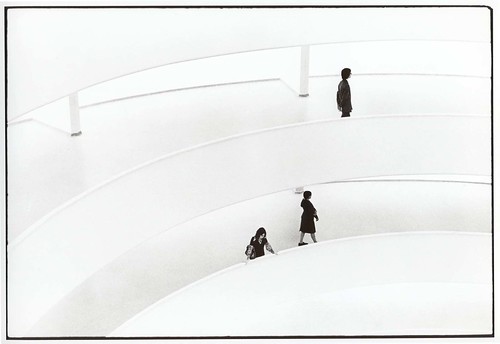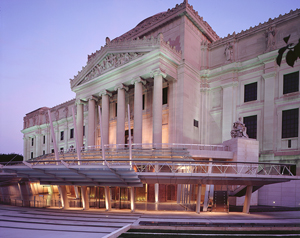I feel like there has been a lot in the press lately about urban design and the "democratic" city. One of the endless fascinating things about urban life is how it is both public and private, accessible and inaccessible. The city for Baudelaire's flâneur is all about roaming about and being inspired, titillated, and entertained by the people and places of the city. I always felt as a longtime New Yorker that I am never alone as long as I have the city streets. But of course, the city has its flip side-- you can see and be seen, but you can also see where you are not welcome, or be seen in an unpleasant way, stared at out of curiosity, fear, or horror, or shoved out because you don't belong.
- In the Doors of Perception blog, an
interview between John Thackera and Sunil Abraham is mainly about eco politics and sustainability in building cities. They emphasize a balance between speed and "slowth" (must be a british thing), not abandoning all goals of modernity and efficiency, but emphasizing local resources and measured mobility alongside speed of information. Their comments on urban planning as a government/commerce project are great:
JT. Show me a city with a “dynamic image” and I will show you an unsustainable city. “Dynamic” usually means high entropy buildings, financial speculation on a massive scale, and a low degree of social participation. From now on, the most interesting cities will be those whose citizens are able to invest their energy and creativity on “re-inhabitation” within the unique ecosystems of their place. This approach will often involve adaptive or more intense uses of existing infrastructure rather than the construction of signature buildings - and sometimes this approach will mean building nothing, nothing at all. To live sustainably we need to place more value on the here and now: a lot of destruction is caused when design is obsessed with the there, and the next - and the “dynamic”.SA. First, the dynamism of a city can be found in the informal sector which in most developing countries accounts for 70% of employment. It is also where legal, technical and market limits and norms are challenged and redefined as everyday practice. The informal economy also has a much lighter infastructure. [...]
This last comment strikes me as so smart-- all the action is in the "informal sector" where streamlined resource use is not about "efficiency" or government protocol, but about reality. This "informal economy" is also run by personal relationships, not bureaucracy:
[SA continues]:
...non-market micro-economies such as gifting, barter, collectives and commons in developing countries are more effective than classical development interventions in addressing problems of social development. For example, home-based care is cheaper and more effective than hospice-based care for people living with HIV/AIDS. I would like to see more celebration of the informal sector, informal practices and non-market micro-economies.
- On a way fluffier note, the weird NY Times T Magazine style blog had a post about
"off-limits" NY places. It is probably true that being hard to get into increases the "magnetism" of some spaces-- this is the whole model on which social clubs are based, right? I was glad to see a lengthy comment bemoaning the "travesty" of having so many architectural wonders of NY as spaces only for the rich. No mention of wheelchair accessibility (unsurprisingly) but I was thinking about what kind of exclusivity physical inaccessibility makes. When I walk around New York, I am often aware of how style and physical access are twinned, that high-end places often involve some form of physical venture to get into-- made all too clear to me, for example, when I mistakenly took my nonogenarian grandmother to a gorgeous, exquisitely designed vegetarian Korean restaurant where the seating was on the floor with legs shoved into a recessed hole under the table. Is a lack of ramp, or a narrow dark passageway, or the big heavy door at so many galleries and fancy stores, the same kind of message as a bouncer or the ubiquitous "girl with a list" at NY parties (or so I see when I walk by them)? It's a bit different, to be sure. Maybe it's more about asking you to feel unsafe for a second, increasing the "magnetism" via risk and fear? The more I look the more i think that the whole high-end fashion/design world is about this-- making you feel uncomfortable as a gateway. Ugh.






